Digital transformation, for companies across the world, has become a matter of survival. Implementation of new technologies in organizations is not an option anymore, it is a must!
As many digital transformation projects still fail, in this blog we will focus on some of the best practices for implementing digital transformation efforts.
Digital Transformation Defined
Digital transformation is a term used to describe changes in organizational activities, processes, competencies and models.
The main goal of every digital transformation process is to fully leverage changes and opportunities of emerging digital technologies and their impact on business performance and success.
In most changes happening within organizations, human element is the key for successful digital transformation. New employee skills, healthy organizational culture, employee communication and employee empowerment are some of the crucial prerequisites for successful digital transformation.
Every digital transformation journey needs a staged approach with a clear set of goals and a road-map, involving a variety of stakeholders.
Even though 84% of companies believe that digital transformation is crucial for the business, only 3% have finished a company-wide initiative
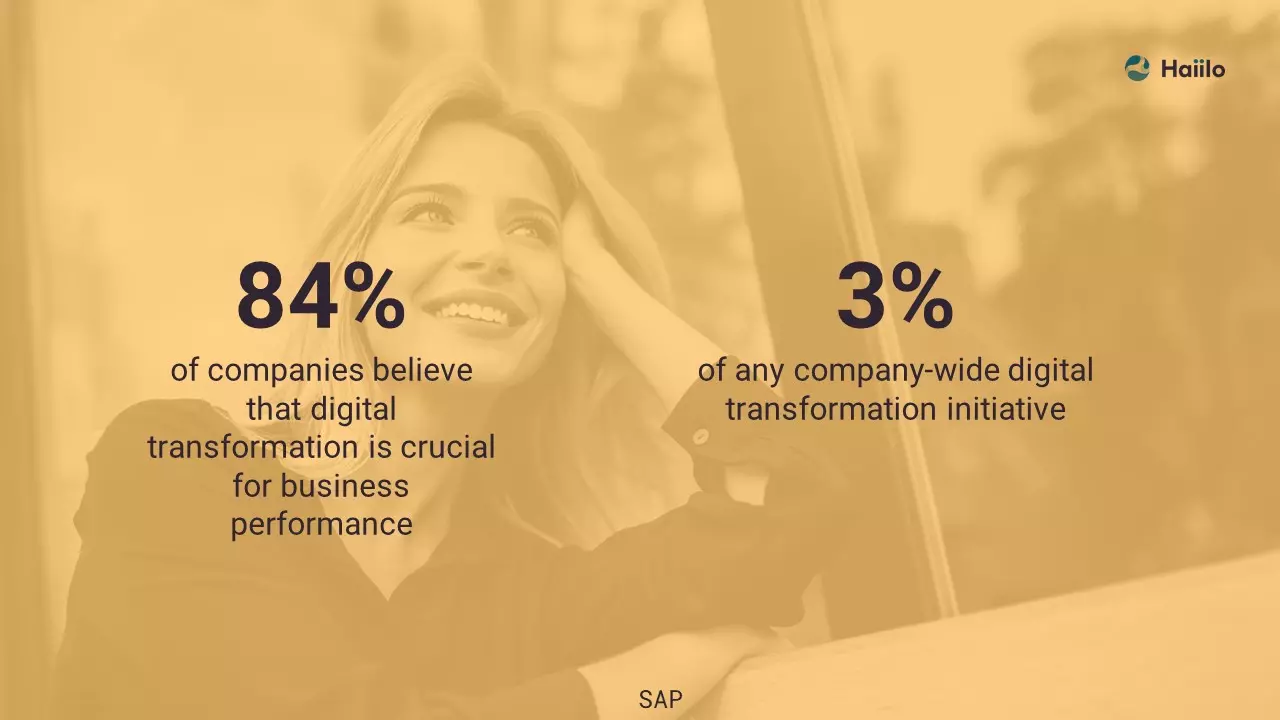
15 Digital Transformation Best Practices
As most digital transformation projects never get implemented, we will now go over some of the digital transformation best practices.
1. Get executive buy-in
If C-level executives are not on-board with digital transformation, the project is very likely to fail.
Digital transformation is a top-down initiative, and it should be led with a vision from the C-suite. Moreover, the owners of most digital transformation efforts are CIOs and CEOs.

As digital transformation requires change at all levels of an organization, it is not surprising that projects like this require effective leadership.
Remember, digital transformation simply can’t be done in siloed environments.
2. Get your internal comms on board
Even though this is a crucial step, many organizations still neglect it. Poor workplace communication often leads to employee frustration and dissatisfaction.
If we know that digital transformation is impossible without employees, how do we manage to leave them uninformed or concerned?
Still, in transformation projects, employees are often left out with uncertainties, leadership changes, lack of basic involvement, poor internal communication and management patterns.
💡 Check out why internal communication is crucial for digital transformation.
Bellow, we will go over a few ways internal comms can help more efficient digital transformation.
3. Communicate clearly to align your employees
71% of leaders cite the workforce as either very or extremely important in supporting their digital transformation strategy.
Getting leaders on board is the first step towards successful digital transformation. However, if leaders with the help of IC departments fail to align employees with the new goals, the project is unlikely to get implemented.
Clear communication is critical during digital transformation. Employees need to understand where the organization is headed, why it is changing, and why the changes are important. At organizations that follow this practice, successful transformation is more than three times more likely.
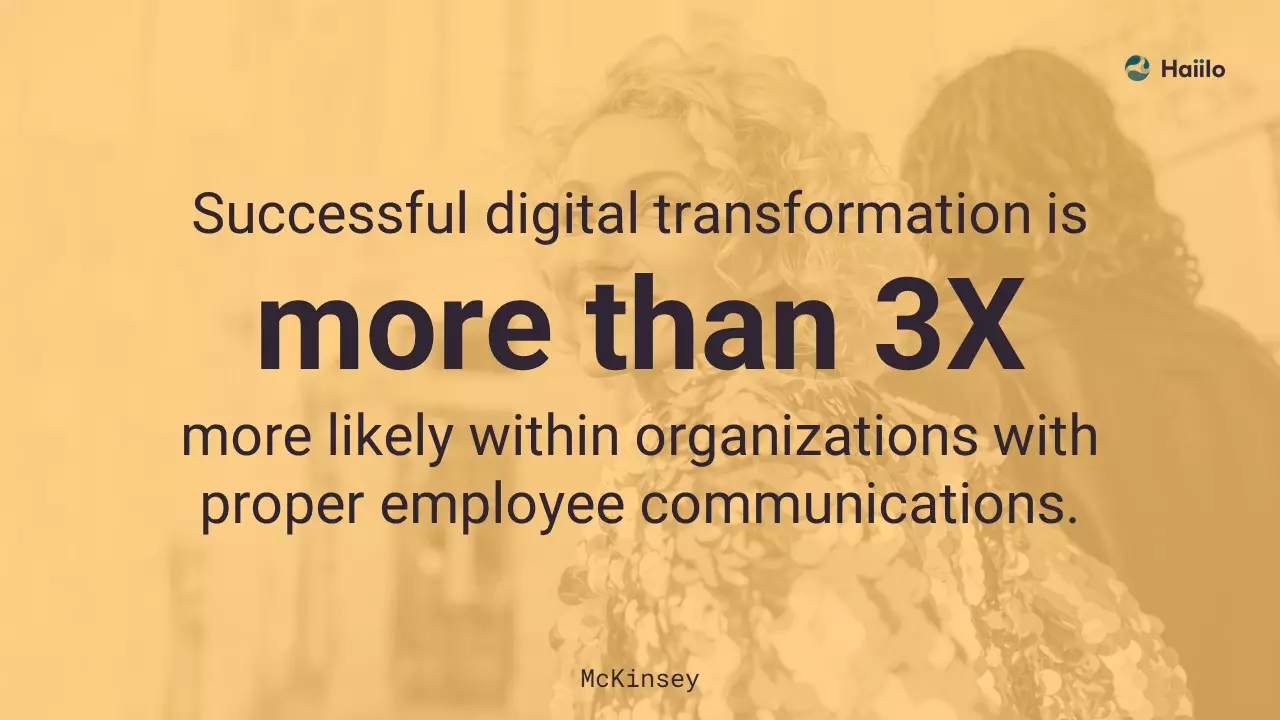
4. Create a sense of urgency
Without a sense of urgency, it is hard to motivate employees and other stakeholders to take actions and engage.
Therefore, for a digital transformation project to get implemented, senior leaders should foster a sense of urgency for making the changes. This is the practice where good leadership communication is crucial.
A great research done by McKinsey, shows the influence of communicating the “change story” on the success rate of digital transformation.
Here is what’s important to communicate to your employees.
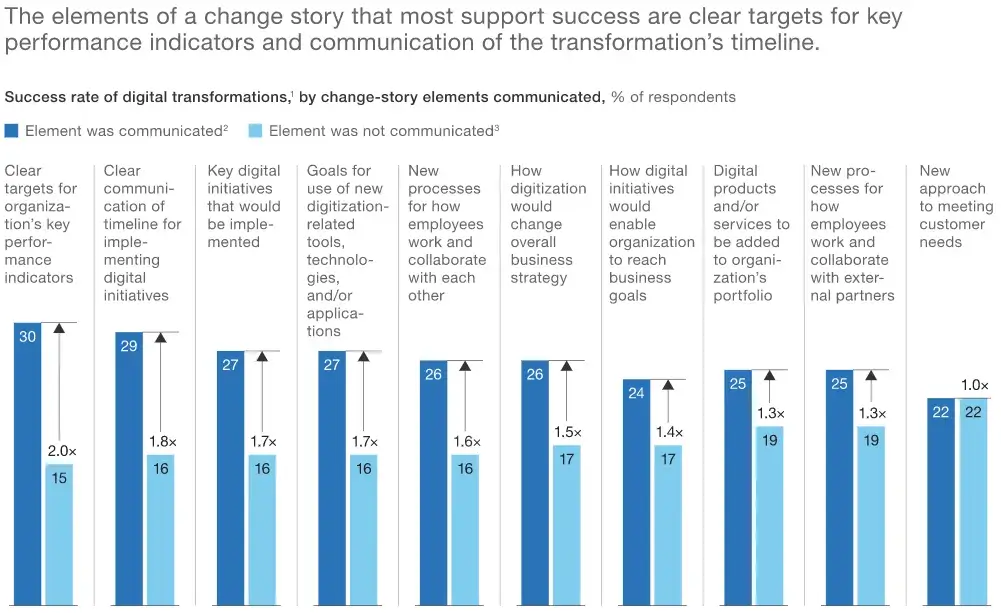
5. Work on your organizational culture
Resistance to change and organizational culture are some of the main barriers to transformation. In fact, 46% of organizations say that company culture and employees’ resistance to change are their biggest challenges.
After all, we need to understand that our employees were developed for a different type of work performed under different circumstances. Therefore, culture and employee experience must undergo a significant evolution to accelerate change from the inside out.
6. Support the culture of innovation
Companies that are most advanced in their digital efforts managed to turn their company culture into an internal accelerator of innovation and transformation.
To add, over 47% of executives say that they are investing in building a culture of innovation at their companies.
Many of them have already assembled in-house innovation labs with dedicated resources.
To drive that culture of innovation, the whole workplace needs to be aligned and on the same page. As it can be extremely hard to embed new behaviors within organizations, it is the leaders’ and internal communications’ job to drive those behaviors through efficient communication with employees.
7. Eliminate the fear
Often times, employees have a perception that digital transformation could threaten their jobs. Therefore, it is not uncommon to see that employee sabotage the project or are resistant to change.
It is critical for leaders to recognize employees’ fears and to emphasize that digital transformation processes are the opportunity for employees to upgrade their skills, careers and expertise.
According to research, 67.8% of companies report that technology disruption has had a neutral-to-positive impact on job creation. 37.3% report a net increase in job creation because of it.
To break the fear among employees, leaders and internal communications (IC) departments must have a clear, well-set and proactive IC strategy during digital transformation.
8. Communicate frequently
Internal communication is known to be one of the most important factors that drive positive employee experience and positive workplace culture.
Moreover, lack of communication has a negative impact on employee motivation, engagement and productivity.
Therefore, one of the main characteristics of companies with successful digital transformation is good internal communications. In addition, for organizations that listen to their employees and encourage two-way relationships, it is much easier to eliminate the fear and achieve employee alignment.
As we mentioned earlier, without having employees on board, DX can never work. On the other side, we can not expect from our employees to be successful if we don’t communicate with them regularly.
9. Engage all your employees
Only 10.9% of digital transformation is currently driven by line employees, signaling a potential issue with employee engagement regarding digital transformation initiatives.
To fix that, during digital transformation, leaders, managers and internal communications departments should always make sure that important information reaches all employees involved.
This can be extremely hard to achieve on a global level and the increasing number of remote employees.
The right communications solutions such as Haiilo are designed to deliver important information to employees when they need it the most.
10. Close the skill gap
Lack of digital skills is another significant barrier for DX implementation. Even though many DX projects are designed to improve employees’ digital skills, organizations need to think about desired skills and expertise before starting the project.
According to research, 90% of jobs are seen to require digital skills in the future. In contrary, 44% of workers aged between 16 and 74 in Europe do not have basic digital skills.
For that reason, investment in people and new skill development is crucial for digital transformation.
Following this trend, 52% of companies are planning to invest in upgrading employees skills.

1. Form a cross-functional committee
Appointing people responsible and accountable for DX delivery makes the whole process much more efficient and streamlined.
DX teams are responsible for managing digital transformation efforts and ensuring cross functional collaboration.
According to research, 51% of companies have steering committees that have earned executive support and resource allocation. These committees include cross-functional and interdepartmental members and are essential to driving meaningful change across enterprises.
However, interdepartmental and cross-functional collaboration is not an easy task. The right internal communication and collaboration technology, however, can make it much more effective.
12. Be agile, but formal
Companies that are most successful in their digital transformation efforts are adaptive, agile and innovative.
However, being agile doesn’t mean that there should be no formality. Lack of formal DX strategy and plan is often the reasons why projects never get fully implemented.
Yet, only one-third of companies prioritize creating a formal innovation program — and even fewer believe it’s important to the long-term success of their transformation efforts.
13. Encourage knowledge sharing
Digital transformation is all about learning new skills and technology. Naturally, some of your employees are more tech savvy than the others.
Do your employees have a way to easily share knowledge with one another?
Consider implementing a communications solution that makes collaboration and teamwork faster, more fun and engaging.
14. Ensure easy access to important information
Before, during and after digital transformation process, employees should have an easy access to all important updates, documents and other information.
For large enterprises, this is always a challenge.
As many of them use various communication channels such as emails and file storage, it is common for important information to get lost. In addition, extensive search for information can have a negative impact on employee productivity.

Therefore, make sure that your employees have a centralized place with an easy and mobile-friendly access to relevant information.
15. Spot and reward your DX influencers
Some employees will be more engaged in your digital transformation process. Some will be resistant, some will work hard to support the initiative.
It is important to measure employee engagement and spot the influencers as they can have a very positive impact on other employees’ attitudes and opinions.
Internal communications solutions like Haiilo enables companies to measure the impact of employee engagement and get the best out of employee advocacy initiatives.
12 Benefits of Digital Transformation
Let’s now go over the 14 benefits of investing in digital transformation within your company.
1. Drives competitive advantage
Companies that invest in digital transformation have a big competitive advantage over the ones that don’t.
As new technology solutions help us improve business processes, employee and customer experience, it is not surprising that companies undergoing digital transformation have much better business results.
In addition, organizations that invest in new technology are more likely to attract and retain top-notch talent.
2. Improves operational efficiency
Technology is here to help us improve our business processes. When conducting digital transformation within an organization, leaders aim to eliminate operational bottlenecks and optimize existing efforts.
Improving operational efficiency is voted as the number one benefit of digital transformation.
3. Increases revenue
Greater profitability is one of the main goals for every CEO.
As digital transformation drives efficiency and better business operations, it has a positive impact on revenues and profitability. Moreover, 56% of CEOs said that digital improvements have led to revenue growth.
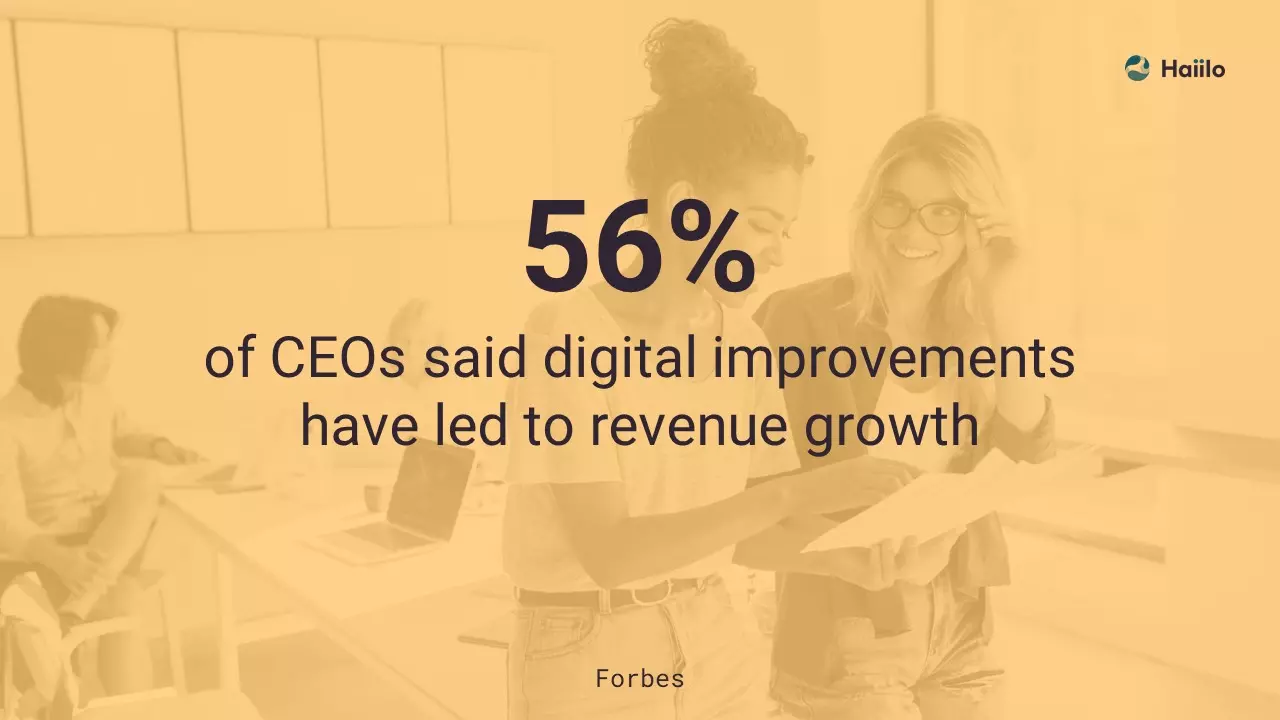
4. Drives agility and innovation
Agility is the ability to easily adapt to changes and continuously improve business processes.
When it comes to digital transformation initiatives, 68% of companies rank agility among the top three considerations.
As Dr. Brigit Koenig, CEO of German’s Allianz Health, said,
“It’s never over. There is always change and always more to do.”
Rapid development and changes within digital landscape leave no time for companies to postpone or neglect innovation.
There will always be new competition, new tools, best practices and new trends. With that, the customers and employees will demand more, wanting better products, services and working conditions.
5. Improves customer experience
There are many digital solutions in the fields of sales and marketing that have a significant influence on customer experience.
Moreover, 92% of leaders are developing mature digital transformation strategies, specifically to enhance the consumer experience.
Technology such as CRM solutions enable us to follow customers throughout their journey and create more personalized messages towards them.
According to Accenture, 75% of customers admit being more likely to buy from a company that:
- Recognizes them by their name,
- Knows their purchase history, and
- Recommends products based on their past purchases.
6. Improves employee experience
Even though most digital transformation efforts still focus on customers and business performance, we are now seeing much more focus on employees.
Organizations are now implementing technology for more efficient employee communication, employee engagement, career development, feedback and recognition all with the goal to improve employee experience, engagement, productivity and retention.
7. Enables employees to do their jobs better
Some of the most common digital transformation efforts are related to employee enablement and productivity.
Technologies that provide data-driven performance insights, real-time analytics and KPI dashboards, enable employees to do their jobs more efficiently.
For example, they can drive higher productivity as well as faster response to customer requests. Another example includes technology with automated alerts to inform employees of required actions that help employees prioritize.
8. Makes communication and collaboration easier
Employees’ productivity depends greatly on how they share information and communicate with each other. Therefore, investments in employee communication and collaboration tools are higher than ever before.
Digital technology such as Haiilo makes important information available and easily accessible for employees.
Open communication and access to this information fosters trust and helps make the work environment less hierarchical and siloed.
9. Closes the skill gaps
Not only that employee related technology helps deliver better employee experience, but it also closes the skill gaps that most organizations are facing today.
A report by Altimeter concluded that 31% of companies lack digital talent among their workforce and leadership.
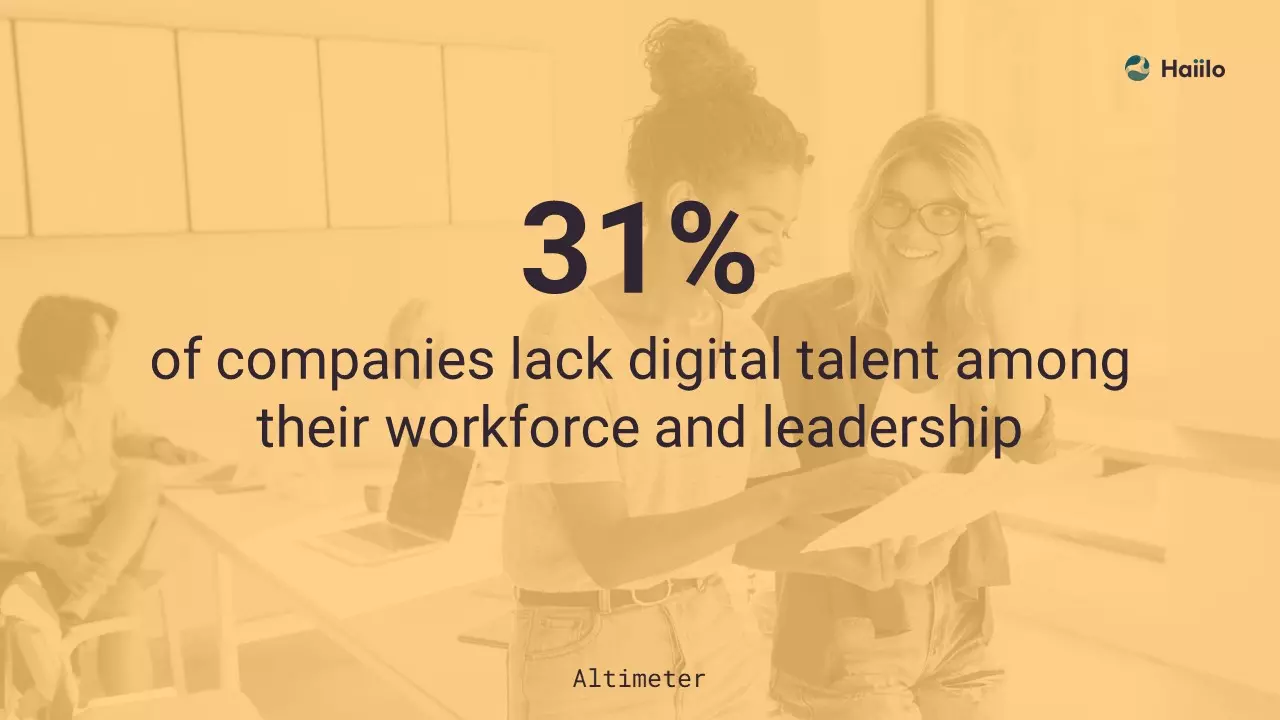
10. Creates a digital company culture
Digital transformation is a great way to create an innovative and digital company culture. Moreover, 27% of companies confirmed that creating a digital culture that’s more literate, adaptive and innovative is one of their primary goals with digital transformation.
This allows the workforce to remain productive and engaged in the transformation without feeling overwhelmed or disconnected from the process.
However, implementing new technologies is not enough. Organizations must be ready to adopt, foster and support company culture that embraces the change.
11. Improves decision making
Over the past few years, we’ve seen a significant explosion of data available for us to use. However, not many businesses have a clear understanding of how to capitalize on this data. There are great tools out there that enable us to turn raw data into meaningful business information.
This is where digitally-driven companies have the upper hand. Using modern Business Intelligence tools, they can get valuable insights and make better decisions based on real data.
12. Introduces new revenue streams
Similar to increase in revenues and profits, most leaders strive towards expanding revenue streams and sources.
Digitalization enables us to do so. According to research, 62% of IT executives are focusing on the development of new digital revenue streams.
Employee Communication is Crucial for Digital Transformation
As mentioned earlier in this blog, employee engagement and communication are some of the most important prerequisites for successful digital transformation efforts.
Therefore, organizations now must consider implementing new communication technologies that enable leaders and internal comms departments reach every employee with relevant information.
With employee communications solutions such as Haiilo, organizations are able to:
- Easily reach all employees with relevant information and updates
- Reach all employees regardless of their location
- Create and share more personalized content to drive employee engagement
- Make all the content easily shareable within and outside the organization
- Support two-way conversations with employees
- Achieve a complete organizational and strategic alignment
- Help employees keep important documents, messages and conversations in one place
- Enable employees to have instant access to information on their mobile phones
- Better filter and prioritize content delivery to prevent information overload










